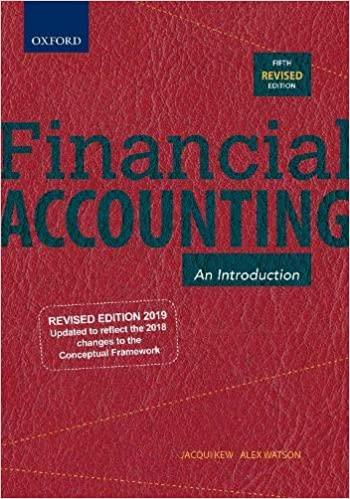Question
Problem 13-23A Ratio analysis LO 13-2, 13-3, 13-4, 13-5 The following financial statements apply to Adams Company: Year 4 Year 3 Revenues Net sales $
Problem 13-23A Ratio analysis LO 13-2, 13-3, 13-4, 13-5
The following financial statements apply to Adams Company:
| Year 4 | Year 3 | ||||||
| Revenues | |||||||
| Net sales | $ | 211,300 | $ | 176,500 | |||
| Other revenues | 9,400 | 6,800 | |||||
| Total revenues | 220,700 | 183,300 | |||||
| Expenses | |||||||
| Cost of goods sold | 125,000 | 101,000 | |||||
| Selling expenses | 19,700 | 17,700 | |||||
| General and administrative expenses | 10,900 | 9,900 | |||||
| Interest expense | 2,000 | 2,000 | |||||
| Income tax expense | 19,600 | 16,100 | |||||
| Total expenses | 177,200 | 146,700 | |||||
| Net income | $ | 43,500 | $ | 36,600 | |||
| Assets | |||||||
| Current assets | |||||||
| Cash | $ | 5,500 | $ | 7,200 | |||
| Marketable securities | 1,900 | 1,900 | |||||
| Accounts receivable | 35,200 | 31,700 | |||||
| Inventories | 101,100 | 95,900 | |||||
| Prepaid expenses | 4,700 | 3,700 | |||||
| Total current assets | 148,400 | 140,400 | |||||
| Plant and equipment (net) | 106,200 | 106,200 | |||||
| Intangibles | 21,100 | 0 | |||||
| Total assets | $ | 275,700 | $ | 246,600 | |||
| Liabilities and Stockholders Equity | |||||||
| Liabilities | |||||||
| Current liabilities | |||||||
| Accounts payable | $ | 40,000 | $ | 54,900 | |||
| Other | 15,900 | 15,200 | |||||
| Total current liabilities | 55,900 | 70,100 | |||||
| Bonds payable | 64,200 | 65,200 | |||||
| Total liabilities | 120,100 | 135,300 | |||||
| Stockholders equity | |||||||
| Common stock (48,000 shares) | 115,000 | 115,000 | |||||
| Retained earnings | 40,600 | (3,700 | ) | ||||
| Total stockholders equity | 155,600 | 111,300 | |||||
| Total liabilities and stockholders equity | $ | 275,700 | $ | 246,600 | |||
Required Calculate the following ratios for Year 3 and Year 4. Since Year 2 numbers are not presented do not use averages when calculating the ratios for Year 3. Instead, use the number presented on the Year 3 balance sheet. a. Net margin. (Round your answers to 2 decimal places.) b. Return on investment. (Round your answers to 2 decimal places.) c. Return on equity. (Round your answers to 2 decimal places.) d. Earnings per share. (Round your answers to 2 decimal places.) e. Price-earnings ratio (market prices at the end of Year 3 and Year 4 were $6.08 and $4.80, respectively). (Round your intermediate calculations and final answers to 2 decimal places.) f. Book value per share of common stock. (Round your answers to 2 decimal places.) g. Times interest earned. Exclude extraordinary income in the calculation as they cannot be expected to recur and, therefore, will not be available to satisfy future interest payments. (Round your answers to 2 decimal places.) h. Working capital. i. Current ratio. (Round your answers to 2 decimal places.) j. Quick (acid-test) ratio. (Round your answers to 2 decimal places.) k. Accounts receivable turnover. (Round your answers to 2 decimal places.) l. Inventory turnover. (Round your answers to 2 decimal places.) m. Debt-to-equity ratio. (Round your answers to 2 decimal places.) n. Debt-to-assets ratio. (Round your answers to the nearest whole percent.)
| |||||||||||||||||||||||||||||||||||||||||||||||||||||||||||||||||||||||||||||||||||||||||||
Step by Step Solution
There are 3 Steps involved in it
Step: 1

Get Instant Access to Expert-Tailored Solutions
See step-by-step solutions with expert insights and AI powered tools for academic success
Step: 2

Step: 3

Ace Your Homework with AI
Get the answers you need in no time with our AI-driven, step-by-step assistance
Get Started


